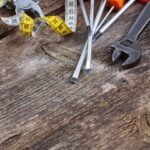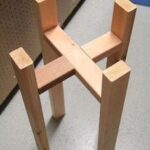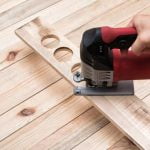Dogs have a natural inclination to chew, but when they start targeting your woodwork, it can become a frustrating and costly problem. Understanding the behavior of dogs chewing on woodwork is essential in order to address the issue effectively.
This article provides insights into why dogs engage in this behavior and explores the potential dangers it poses. By recognizing the signs of woodwork chewing and implementing the right training techniques, you can teach your dog not to indulge in this destructive habit.
Many dog owners wonder why their furry friends are drawn to chew on woodwork in the first place. Uncovering the root causes behind this behavior is crucial for finding a solution. From teething and boredom to anxiety or even nutritional deficiencies, there are various reasons why dogs exhibit such behavior. By understanding these underlying causes, you can tailor your approach towards preventing woodwork chewing.
The dangers of dogs chewing on woodwork extend beyond just damaged furniture. It can result in potential health hazards for your pet as well as structural damage to your home. Splinters from chewed wood may puncture your dog’s mouth or digestive tract, leading to infections or blockages.
Moreover, repeated destruction of woodwork can be an expensive problem to fix and may decrease the aesthetic appeal and value of your home. It is important to address this issue promptly before it escalates into more serious consequences.
By acknowledging the behaviors associated with dogs chewing on woodwork and recognizing its potential risks, you are equipped with the knowledge necessary to tackle this issue head-on. In the following sections, we will explore effective training techniques that can help you teach your dog not to chew on woodwork, as well as ways to provide suitable alternatives for them.
Additionally, we will discuss protective measures you can take and how addressing underlying issues such as anxiety and boredom can contribute towards long-term behavioral change. And if all else fails, we will also delve into when it might be necessary to seek professional help from a dog behaviorist or trainer.
Why Dogs Chew Woodwork
Understanding why dogs chew woodwork is essential in addressing the behavior effectively. There are several underlying reasons that can contribute to this destructive habit.
One common cause of woodwork chewing is teething. Just like human babies, puppies go through a teething phase during which their gums become itchy and painful. Chewing provides them relief and helps with the loosening of their baby teeth as well as the eruption of adult teeth. It is important for dog owners to provide appropriate chew toys during this stage to redirect their puppy’s chewing behavior away from woodwork.
Another reason why dogs chew on woodwork is boredom or lack of mental stimulation. Dogs have a natural instinct to explore and investigate their surroundings, and if they do not have enough activities to engage their minds, they may resort to chewing on furniture or woodwork out of sheer frustration. Ensuring that your dog receives plenty of exercise, playtime, and mental enrichment can help prevent these behaviors.
Anxiety and stress can also be contributing factors behind woodwork chewing in dogs. Separation anxiety, fear, or changes in the environment can trigger destructive behaviors as a coping mechanism for dogs. It is important to address any underlying anxiety issues through positive reinforcement training techniques or seeking professional help when necessary.
By understanding the root causes of why dogs chew on woodwork, owners can take proactive steps in addressing the behavior more effectively. Whether it is providing appropriate chew toys during teething, increasing mental stimulation and exercise to combat boredom, or addressing anxiety issues head-on, identifying the underlying factors will lead to successful training outcomes and happier, healthier dogs.
The Dangers of Dogs Chewing Woodwork
Woodwork may seem harmless, but when dogs chew on it, there can be potential health risks and damage involved. Understanding these dangers is crucial in order to address the problem effectively.
Potential Health Risks
When dogs chew on woodwork, there is a risk of them ingesting small pieces of wood, paint, or other materials that could cause harm. These foreign objects can lead to gastrointestinal blockages or injuries in the digestive system. Ingesting toxic substances such as paint or wood treatments can also be detrimental to a dog’s health.
Additionally, chewing on woodwork can result in dental problems for dogs. The splintering and hard texture of wood can damage their teeth, leading to broken or cracked teeth, gum injuries, or even infections.
Damaging Effects on Property
In addition to the health risks posed by dogs chewing on woodwork, there are also potential damages to consider. Wooden furniture, baseboards, door frames, and other structures can be ruined by persistent chewing. This not only affects the aesthetic appeal of your home but may also decrease its value.
Chewing on woodwork can also result in costly repairs or replacements. Repeated chewing can weaken the structure of furniture or wooden items over time, compromising their integrity and functionality.
Preventing Health Risks and Damage
To minimize the dangers associated with dogs chewing on woodwork, it is essential to identify and address this behavior promptly. This may involve a combination of training techniques and providing suitable alternatives for chewing.
By understanding both the potential health risks and property damage caused by dogs chewing on woodwork, pet owners can take necessary steps to protect both their beloved pets and their homes from harm.
Identifying Signs of Woodwork Chewing
Chewing is a natural behavior for dogs, but when they start targeting woodwork in your home, it can be a frustrating problem to deal with. To effectively address this issue, it’s crucial to first identify the signs of woodwork chewing and recognize that there is a problem. By understanding these signs, you’ll be able to take appropriate action and implement the necessary training techniques.
One common sign of woodwork chewing is the presence of teeth marks or damage on furniture edges, door frames, baseboards, or other wooden surfaces. You may also notice small wood fragments or splinters around these areas. Additionally, if your dog seems particularly fond of certain wooden objects or areas in your home and frequently spends time sniffing or licking them, it could be an indication that they are attracted to chewing on woodwork.
Another sign to watch out for is the sudden disappearance of any wooden items in your home. If you regularly find chewed-up pieces of wood hidden or scattered around your house, it’s a clear sign that your dog has been chewing on woodwork. Keep an eye out for any changes in your dog’s behavior as well. They may display increased restlessness or exhibit anxious behaviors like pacing or excessive barking.
To accurately identify the problem of woodwork chewing, it’s important to rule out any potential underlying health issues that may be causing this behavior. Dental problems such as tooth decay or gum inflammation can sometimes lead dogs to seek relief by chewing on hard surfaces like wood. If you suspect that health issues are contributing to the problem, consult with your veterinarian to address those concerns alongside behavioral training techniques.
Once you have identified the signs of woodwork chewing and confirmed there is a problem, you can move forward with implementing effective training techniques to teach your dog not to chew on woodwork.
Effective Training Techniques
Woodwork chewing can be a frustrating and damaging behavior in dogs. Fortunately, there are effective training techniques that can help teach your dog not to chew on woodwork. Consistency and patience are key when it comes to changing your dog’s behavior, so it’s important to approach the training process with a positive attitude and realistic expectations.
One of the most effective training techniques for preventing woodwork chewing is redirection. This involves redirecting your dog’s chewing behavior onto appropriate objects, such as chew toys or bones. Whenever you catch your dog chewing on woodwork, calmly remove them from the area and offer them an alternative chew toy or bone instead. Praise and reward your dog with treats or verbal praise when they choose the appropriate object to chew on.
Another technique that can be helpful is using taste deterrents. There are several commercial products available that have a bitter taste, which can deter dogs from chewing on woodwork. Apply these deterrents to the areas of woodwork that your dog tends to chew on, following the manufacturer’s instructions. Be sure to also provide plenty of appropriate chew toys and bones for your dog as an alternative.
Consistency is crucial in any training process. It’s important to be consistent in both redirecting your dog’s chewing behavior and providing suitable alternatives for them to chew on. Additionally, make sure everyone in the household is aware of and follows these training techniques consistently.
Overall, teaching your dog not to chew on woodwork requires patience and consistency. By using redirection techniques, taste deterrents, and providing suitable alternatives for chewing, you can help encourage better behaviors in your furry friend.
| Training Technique | Description |
|---|---|
| Redirection | Redirect your dog’s chewing behavior onto appropriate objects such as chew toys or bones |
| Taste deterrents | Use commercial products with a bitter taste to deter dogs from chewing on woodwork |
| Consistency | Be consistent in redirecting your dog’s behavior and providing suitable alternatives for chewing |
Providing Alternative Chews
The Importance of Providing Alternative Chews
One effective way to stop dogs from chewing woodwork is by providing them with suitable alternative chews. Dogs have a natural instinct to chew, and it is important to redirect this behavior towards appropriate items. By offering alternative chews, you can satisfy your dog’s chewing needs while protecting your woodwork from further damage.
Choosing Suitable Substitutes for Woodwork
When selecting alternative chews for your dog, it is crucial to choose items that are safe, durable, and appealing to them. Look for chews that are specifically designed for dogs and made from materials that are tough enough to withstand their chewing habits.
There are various options available in the market such as rubber toys, nylon bones, and puzzle toys filled with treats. These types of chews can keep your dog engaged and entertained while promoting healthy chewing habits. Additionally, there are also natural alternatives like antlers or rawhide bones that can provide an enjoyable chewing experience for your furry friend.
Introducing and Encouraging the Use of Alternative Chews
Once you have chosen suitable alternative chews for your dog, it is important to introduce them properly. Start by presenting the chew toys as something exciting and rewarding. You can reinforce this by playing interactive games with your dog using these toys or even stuffing them with tasty treats.
Whenever you catch your dog attempting to chew on woodwork, redirect their attention towards the approved chew toy instead. Encourage and praise them when they engage with the appropriate item. Remember to consistently offer the alternative chews whenever you notice your dog’s urge to chew on woodwork.
By providing suitable substitutes for woodwork and teaching your dog where it is acceptable to chew, you can effectively break their habit of damaging valuable wooden items in your home. This technique not only protects your belongings but also promotes positive chewing behaviors in dogs.
Protective Measures
Dogs are naturally curious creatures and their exploration often leads them to chew on various objects, including woodwork. To protect your woodwork and prevent further damage, it is essential to take protective measures that not only prevent access but also minimize temptation for your furry friend.
One of the most effective protective measures is to create physical barriers between your dog and the woodwork. This can be done by using baby gates or pet playpens to restrict access to certain areas where the woodwork is located. Additionally, you can use indoor pet fences or exercise pens to create designated areas for your dog to roam freely without having access to the woodwork.
Another option is to use deterrents that make the woodwork unattractive or unpleasant for dogs to chew on. There are various commercial sprays available that have a bitter taste, which discourage dogs from chewing. These sprays can be applied directly onto the woodwork, making it less appealing for them. However, it’s important to check with your veterinarian if these sprays are safe and non-toxic for your specific breed of dog.
In addition to physical barriers and deterrents, providing your dog with appropriate chew toys can help redirect their chewing behavior away from the woodwork. It is crucial to find chew toys that are specifically designed for dogs and provide a similar texture or sensation as the woodwork they are attracted to. By providing suitable substitutes, you can satisfy their urge to chew while protecting your valuable wooden surfaces.
| Protective Measure | Description |
|---|---|
| Create physical barriers | Use baby gates or pet playpens |
| Apply deterrent sprays | Commercial sprays with a bitter taste |
| Provide chew toys | Find appropriate toys as substitutes |
Managing Anxiety and Boredom
Dogs may exhibit destructive behaviors such as chewing woodwork due to underlying issues like anxiety and boredom. It is essential for dog owners to address these root causes in order to effectively stop the behavior. By managing anxiety and boredom, owners can provide their dogs with a healthy and stimulating environment that discourages woodwork chewing.
One way to manage anxiety is by creating a safe and secure space for your dog. This can be done by providing a designated area, such as a crate or a quiet room, where your dog can retreat when they feel anxious or overwhelmed. Fill this space with comfortable bedding, toys, and interactive puzzles to keep them occupied. Additionally, establishing a consistent routine and incorporating regular exercise into your dog’s day can help alleviate anxiety.
Boredom can also be a major factor in woodwork chewing. Dogs that lack mental and physical stimulation are more likely to engage in destructive behaviors. To address boredom, make sure to provide plenty of toys that are designed to keep your dog engaged and mentally stimulated. Puzzle toys, treat-dispensing toys, and interactive games can all help prevent boredom-related woodwork chewing.
Another effective way to manage anxiety and boredom is through obedience training and positive reinforcement techniques. Teaching your dog basic commands like “sit,” “stay,” and “leave it” not only builds their confidence but also provides mental stimulation. Rewarding good behavior with treats or praise helps reinforce desired actions and keeps dogs engaged in positive activities instead of destructive chewing.
Consistency and Patience
When it comes to stopping dogs from chewing woodwork, consistency and patience are key in fostering long-term behavioral change. While it may be frustrating to deal with this behavior, understanding that it takes time and effort to modify your dog’s habits will greatly increase your chances of success.
Consistency is important because dogs thrive on routine and clear boundaries. In order to effectively train your dog not to chew on woodwork, you must consistently reinforce the desired behavior while redirecting their attention away from the woodwork. This means providing them with alternative chews or toys whenever they show signs of wanting to chew on the woodwork.
Additionally, it is crucial to consistently provide positive reinforcement when they choose not to engage with the woodwork. Whether it’s through verbal praise or treat rewards, consistent reinforcement helps solidify the message that chewing on woodwork is not acceptable.
Patience is another vital component when nurturing long-term behavioral change in dogs. It’s important to remember that changing a habit takes time and won’t happen overnight. Some dogs may respond quickly to training techniques while others may require more time and repetition before improvements are seen.
It’s essential not to lose hope or become discouraged during this process. Consistently practicing training techniques, providing alternative chews, and reinforcing positive behaviors will eventually lead to a long-lasting change in your dog’s behavior.
In addition to consistency and patience, it can also be beneficial to enlist the help of professional trainers or dog behaviorists when dealing with persistent chewing behaviors. They can provide expert guidance tailored specifically for your dog’s needs and offer additional strategies or insights that you may not have considered. Remember that seeking professional help does not indicate failure as a pet owner but rather demonstrates your commitment towards finding a solution for your furry friend.
By consistently reinforcing desired behaviors, redirecting attention away from woodwork, practicing patience, and seeking professional assistance when needed, you can successfully nurture long-term behavioral change in your dog and prevent them from chewing on woodwork. It’s important to remember that every dog is unique, so it may take some trial and error to find the most effective techniques for your specific situation.
With a combination of dedication and understanding, you can help your dog overcome their chewing habits and create a safe environment for both your pet and your home.
Seeking Professional Help
Although many dog owners are able to successfully address their dog’s woodwork chewing behavior on their own, there may be instances where professional help is needed. Consulting a dog behaviorist or trainer can be beneficial when the problem persists despite efforts to resolve it using training techniques and alternative chews.
A dog behaviorist or trainer can provide valuable insights and advice tailored to your specific situation. They have a deep understanding of canine behavior and can help identify any underlying issues that may be contributing to the woodwork chewing. They will be able to assess your dog’s individual needs and create a customized plan for addressing the behavior.
One telltale sign that it may be time to seek professional help is if the woodwork chewing is accompanied by other behavioral problems or signs of anxiety or aggression. A qualified professional can help diagnose any underlying issues and offer strategies for managing them effectively.
Additionally, if you have tried various training methods without success, consulting a professional can give you access to more advanced techniques that may be necessary in more challenging cases. They can also provide guidance on how to adjust your overall approach and ensure consistency in your training efforts.
Remember, seeking professional help does not mean you have failed as a dog owner. It simply means that you recognize the value of expert assistance in resolving an issue that is affecting your dog’s well-being and potentially damaging your home. By working with a dog behaviorist or trainer, you increase your chances of finding an effective solution and creating long-term behavioral change for your canine companion.
Frequently Asked Questions
What can I use to stop my dog from chewing on wood?
To stop your dog from chewing on wood, there are a few options you can try. First, ensure that your dog has plenty of appropriate chew toys and bones to redirect their attention. This will provide them an alternative outlet for their natural chewing instincts. Secondly, using deterrent sprays or bitter-tasting substances specifically designed for dogs can help deter them from chewing on wood surfaces.
Applying these products to the wooden areas that your dog is prone to chewing can discourage them due to the unpleasant taste or smell. Lastly, it is important to provide appropriate exercise and mental stimulation for your dog, as boredom can often lead to destructive behaviors like wood chewing. Ensuring they have enough physical and mental activity throughout the day will decrease the likelihood of them turning to wood as a source of entertainment.
How do I stop my dog from chewing on furniture when left alone?
When attempting to prevent your dog from chewing on furniture while left alone, it’s vital to establish a positive association with being alone and create a safe environment for your pet. Start by gradually increasing the amount of time you leave your dog alone, starting with small intervals initially while providing positive reinforcement like treats or toys when they remain calm and do not engage in destructive behavior.
It may be helpful to confine your dog in a crate or a designated area that is free from items they could chew on until they develop better habits. Additionally, ensuring your dog receives enough physical exercise before being left alone can help tire them out and reduce their desire to engage in destructive behaviors such as furniture chewing.
What can I put on walls to stop dog chewing?
If you need to prevent your dog from chewing on walls, there are different tactics you can employ. First, make sure that your dog has ample stimulating activities and toys to keep them occupied and redirect their urge to chew onto appropriate items rather than walls. Additionally, you can use deterrent sprays or bitter-tasting substances made specifically for dogs on the areas of wall that are prone to be chewed upon.
These products are usually harmless but taste unpleasant to dogs, discouraging them from chewing on the walls. Another option is to create physical barriers such as baby gates or furniture placements that restrict access to the areas your dog tends to chew. Finally, consistent training and supervision are crucial; redirecting their behavior with verbal cues and positive reinforcement can help teach your dog appropriate chewing behaviors and protect your walls from damage.

Hi everyone! I’m a woodworker and blogger, and this is my woodworking blog. In my blog, I share tips and tricks for woodworkers of all skill levels, as well as project ideas that you can try yourself.





